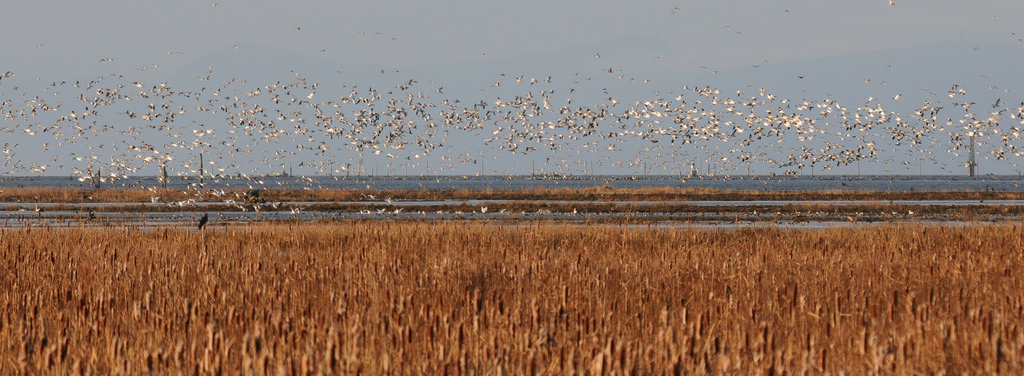A Critical Link along the Pacific Flyway
At its annual meeting this past winter, the Pacific Birds International Management Board reiterated the need to focus in on the Fraser River Delta and Estuary in British Columbia. The conservation of Pacific Flyway estuaries is already a priority for Pacific Birds, but this region is especially vital to the Flyway’s migratory birds. To the Western Sandpiper, those habitats are critical as 95% of the population is believed to pass through during migration. A significant percentage (25-35%) of the Wrangel Island Snow Goose population overwinters here and in the adjacent Skagit River Delta. Thanks to the expansive geography and complex mix of habitats, the bird life is astounding.
The Fraser River is British Columbia’s longest river, meeting the ocean near the rapidly growing urban and industrial areas in and around Vancouver. As the river slows and approaches the Pacific Ocean, deposits accumulate, forming the expansive and fertile delta. This belt of productive, low elevation land is prime for both agriculture and urban and residential development. Starting in the late 1800s with the placement of dikes, thousands of acres of natural delta habitats were converted to agriculture. A number of bird species now forage on those agricultural habitats, which augment the natural vegetation in the estuary.
The estuary—the biologically rich fresh and salt water mix associated with the delta— provides different but equally critical habitat for birds. The estuary is the largest along the Pacific Coast of North America and has the largest concentration of migratory birds in Canada, as well as supporting tens of thousands of wintering birds.
Diverse Habitats, Designations and Threats
It is the sum total of the habitats that make this area so ecologically rich and a magnet for migratory birds. Different species are attracted to the mud and sand flats, intertidal zones, eelgrass, farm land, riparian zones, freshwater wetlands, and coastal forests. The mud flats are chock full of invertebrates, and biofilm provides a major nutrient source for Western and Semipalmated Sandipers as well as Dunlin. The Great Blue Heron, a species of special conservation concern, uses multiple habitats as it feeds and roosts.
This ecological gem has not gone unnoticed. Various parts of the delta and estuary are recognized internationally as an Important Bird Area, Ramsar site, and a Western Hemisphere Shorebird Reserve Network site. The region is within a designated area of special significance in the North American Waterfowl Management Plan. These designations recognize the unique and significant contributions to the Flyway-wide needs of a particular species or multiple species.
Diverse habitats leads to diverse conservation threats to birds. Additional development in the intertidal zones is a large concern, as is the loss of farmland. Vegetative change from sea level rise changes the food picture for birds. Conversion from agriculture to residential or other development especially affects waterfowl and waterbirds.
Along with multiple partners, Pacific Birds is committed to doing its part to keep the Fraser River Delta and Estuary a healthy, mid-Flyway respite for millions of birds. For almost 30 years Joint Venture partners have been working together to establish conservation areas but much more needs to be done. Stay tuned throughout 2018 as we help shine a light on the conservation issues and their potential solutions.

Tom Byrne © Creative Commons
Learn More:
Not all Mudflats are Equal: Roberts Bank, Biofilm, and the Fate of the Western Sandpiper
George C. Reifel Migratory Bird Sanctuary
Environment and Climate Change Canada's Video: Discover Alasksen National Wildlife Area
